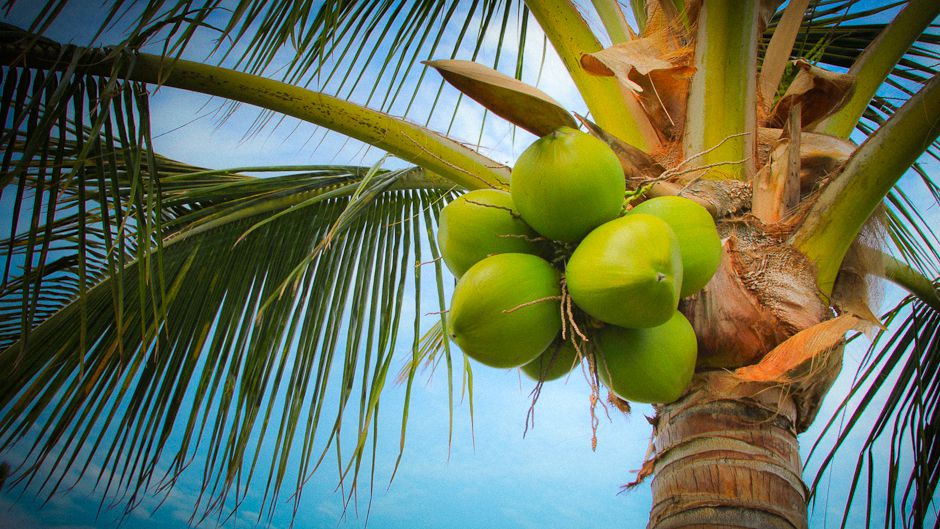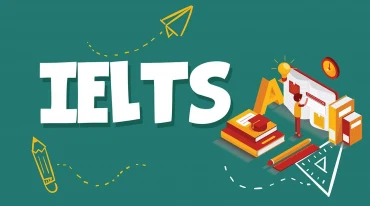
- 357 Lê Hồng Phong, P.2, Q.10, TP.HCM
- Hotline 1: 1900 7060
Hotline 2: (028) 3622 8849
Bài tập IELTS Reading - The coconut palm
The coconut palm

For millennia, the coconut has been central to the lives of Polynesian and Asian peoples. In the western world, on the other hand, coconuts have always been exotic and unusual, sometimes rare. The Italian merchant traveller Marco Polo apparently saw coconuts in South Asia in the late 13th century, and among the mid-14th-century travel writings of Sir John Mandeville there is mention of ‘great Notes of Ynde’ (great Nuts of India). Today, images of palm-fringed tropical beaches are clichés in the west to sell holidays, chocolate bars, fizzy drinks and even romance.
Typically, we envisage coconuts as brown cannonballs that, when opened, provide sweet white flesh. But we see only part of the fruit and none of the plant from which they come. The coconut palm has a smooth, slender, grey trunk, up to 30 metres tall. This is an important source of timber for building houses, and is increasingly being used as a replacement for endangered hardwoods in the furniture construction industry. The trunk is surmounted by a rosette of leaves, each of which may be up to six metres long. The leaves have hard veins in their centres which, in many parts of the world, are used as brushes after the green part of the leaf has been stripped away. Immature coconut flowers are tightly clustered together among the leaves at the top of the trunk. The flower stems may be tapped for their sap to produce a drink, and the sap can also be reduced by boiling to produce a type of sugar used for cooking.
Coconut palms produce as many as seventy fruits per year, weighing more than a kilogram each. The wall of the fruit has three layers: a waterproof outer layer, a fibrous middle layer and a hard, inner layer. The thick fibrous middle layer produces coconut fibre, ‘coir’, which has numerous uses and is particularly important in manufacturing ropes. The woody innermost layer, the shell, with its three prominent ‘eyes’, surrounds the seed. An important product obtained from the shell is charcoal, which is widely used in various industries as well as in the home as a cooking fuel. When broken in half, the shells are also used as bowls in many parts of Asia.
Inside the shell are the nutrients (endosperm) needed by the developing seed. Initially, the endosperm is a sweetish liquid, coconut water, which is enjoyed as a drink, but also provides the hormones which encourage other plants to grow more rapidly and produce higher yields. As the fruit matures, the coconut water gradually solidifies to form the brilliant white, fat-rich, edible flesh or meat. Dried coconut flesh, ‘copra’, is made into coconut oil and coconut milk, which are widely used in cooking in different parts of the world, as well as in cosmetics. A derivative of coconut fat, glycerine, acquired strategic importance in a quite different sphere, as Alfred Nobel introduced the world to his nitroglycerine-based invention: dynamite.
Their biology would appear to make coconuts the great maritime voyagers and coastal colonizers of the plant world. The large, energy-rich fruits are able to float in water and tolerate salt, but cannot remain viable indefinitely; studies suggest after about 110 days at sea they are no longer able to germinate. Literally cast onto desert island shores, with little more than sand to grow in and exposed to the full glare of the tropical sun, coconut seeds are able to germinate and root. The air pocket in the seed, created as the endosperm solidifies, protects the embryo. In addition, the fibrous fruit wall that helped it to float during the voyage stores moisture that can be taken up by the roots of the coconut seedling as it starts to grow.
There have been centuries of academic debate over the origins of the coconut. There were no coconut palms in West Africa, the Caribbean or the east coast of the Americans before the voyages of the European explorers Vasco da Gama and Columbus in the late 15th and early 16th centuries. 16th century trade and human migration patterns reveal that Arab traders and European sailors are likely to have moved coconuts from South and Southeast Asia to Africa and then across the Atlantic to the east coast of America. But the origin of coconuts discovered along the west coast of America by 16th century sailors has been the subject of centuries of discussion. Two diametrically opposed origins have been proposed: that they came from Asia, or that they were native to America. Both suggestions have problems. In Asia, there is a large degree of coconut diversity and evidence of millennia of human use – but there are no relatives growing in the wild. In America, there are close coconut relatives, but no evidence that coconuts are indigenous. These problems have led to the intriguing suggestion that coconuts originated on coral islands in the Pacific and were dispersed from there.
Complete the table below.
Choose ONE WORD ONLY from the passage for each answer.
Write your answers in boxes 1-8 on your answer sheet.
|
THE COCONUT PALM |
||
|
Part |
Description |
Uses |
|
trunk |
up to 30 metres |
timber for houses and the making of 1…………………….. |
|
leaves |
up to 6 metres long |
to make brushes |
|
flowers |
at the top of the trunk |
stems provide sap, used as a drink or a source of 2……………………. |
|
fruits |
outer layer |
|
|
middle layer (coir fibres) |
used for 3………………………, |
|
|
Inner layer (shell) |
a source of 4……………………. (when halved) for 5……………………. |
|
|
coconut water |
a drink a source of 6…………………….. for other plants |
|
|
coconut flesh |
oil and milk for cooking and 7……………………. glycerine (an ingredient in 8……………………….) |
|
Do the following statements agree with the information given in Reading Passage 1?
In boxes 9-13 on your answer sheet, write
TRUE if the statement agrees with the information
FALSE if the statement contradicts the information
NOT GIVEN if there is no information on this
9 Coconut seeds need shade in order to germinate.
10 Coconuts were probably transported to Asia from America in the 16th century.
11 Coconuts found on the west coast of America were a different type from those found on the east coast.
12 All the coconuts found in Asia are cultivated varieties.
13 Coconuts are cultivated in different ways in America and the Pacific.
PHÂN TÍCH TỪ VỰNG:
- Cliches /ˈkliː.ʃeɪ/ (n): hình mẫu (an idea or expression that has been used too often and is often considered a sign)
- Envisage /ɪnˈvɪz.ɪdʒ/ (v) hình dung (to imagine or expect something in the future)
- Flesh /fleʃ/ (n): phần cùi dừa (the soft part of the body of a coconut)
- Vein /veɪn/ (n): vân lá, gân (the frame of a leaf or an insect's wing)
- Cluster /ˈklʌs.tɚ/ (n): từng cụm, từng bó (of a group of similar things or people)
- Fibrous /ˈfaɪ.brəs/ (adj): dạng xơ, sợi (made of fibres, or like fibre)
- Innermost /ˈɪn.ɚ.moʊst/ (adj) ở tận trong cùng (nearest to the centre)
- Charcoal /ˈtʃɑːr.koʊl/ (n): than củi (a hard, black substance similar to coal)
- Derivative /dɪˈrɪv.ə.t̬ɪv/ (n): chất dẫn xuất (a form of something made or developed from another form)
- Sphere /sfɪr/ (n): lĩnh vực, phạm vi (a subject or area of knowledge, work, etc)
- Germinate /ˈdʒɝː.mə.neɪt/ (v): nảy mầm (to (cause a seed to) start growing)
- Cast onto: gieo xuống (to throw something)
- Glare /ɡler/ (v): chói lóa (to shine too brightly)
- Embryo /ˈem.bri.oʊ/ (n): mầm cây (plant that is developing in a seed)
- Voyage /ˈvɔɪ.ɪdʒ/ (n): quá trình, hành trình (a long journey, especially by ship)
- Indigenous /ɪnˈdɪdʒ.ə.nəs/ (adj): thuộc về bản địa (existing naturally or having always lived in a place; native)
- Dispere from /dɪˈspɝːs/ /frɑːm/: phân tán từ (to spread across or move away over a large area)
ANSWER KEY:
1. furniture 2. sugar 3. ropes 4. charcoal
5. bowls 6. hormones 7. cosmetics 8. dynamite
9. FALSE 10. FALSE 11. NOT GIVEN
12. TRUE 13. NOT GIVEN
THƯ VIỆN LIÊN QUAN

Reading là một trong bốn phần thi bắt buộc của bài thi IELTS, đây cũng được xem là phần thi thử thách nhất để chinh phục được band điểm cao. Hãy...

Bài viết cung cấp cho đọc giả Bài tập Reading part 3 - Chủ đề: Why fairy tales are really scary tales - Có đáp án

Bài viết cung cấp cho đọc giả Bài tập Reading part 2 - Chủ đề: The Desolenator: producing clean water - Có đáp án

Bài viết cung cấp cho đọc giả Bài tập Reading part 1 - Chủ đề: Henry Moore (1898-1986) - Có đáp án
Hoặc gọi ngay cho chúng tôi:
1900 7060
 | Chính sách bảo mật thông tin | Hình thức thanh toán | Quy định chung
| Chính sách bảo mật thông tin | Hình thức thanh toán | Quy định chung
Giấy chứng nhận đăng ký doanh nghiệp số 0310635296 do Sở Kế hoạch và Đầu tư TPHCM cấp.
Giấy Phép hoạt động trung tâm ngoại ngữ số 3068/QĐ-GDĐT-TC do Sở Giáo Dục và Đào Tạo TPHCM cấp